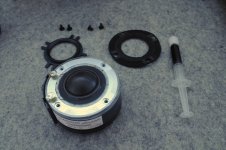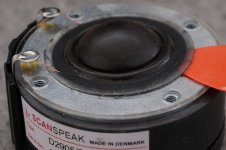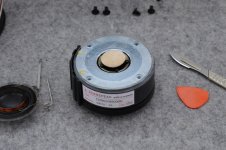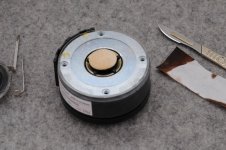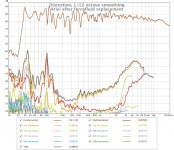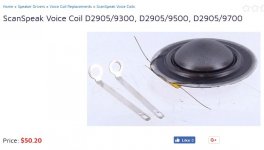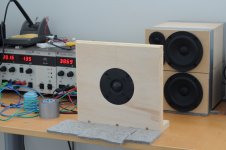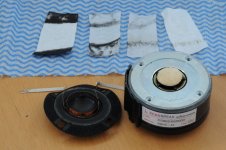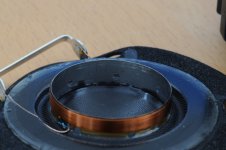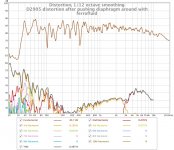Hi guys,
I'm wanting to renew the ferrofluid in one of my D2905/9500 tweeters. See http://www.diyaudio.com/forums/mult...-scan-speak-d2905-950000-a-2.html#post5108838 for the diagnosis of the problem.
Anyway, my ferrofluid has arrived, I've removed the faceplate from the tweeter, then the waveguide, and then a sealing gasket (pulling it away from the face of the tweeter very slowly and gently so as not to stretch or tear it - while it doesn't appear to be glued in, it's still reluctant to move).
Now I'm unsure what to do. There's a clear plastic ring around the outside, and then what appears to be the diaphragm itself inside. I'm unable to get either to move, and I'm reluctant to really hoe in for fear of damaging it.
I'm guessing the diaphragm is glued in? Would heat help to soften it?
Should I just lift the diaphragm itself or would removing the plastic ring first help?
I'm hoping someone here has replaced the diaphragm on a D2905 and is happy to provide pointers...
I've attached a couple of photos that I hope will help.
I'm wanting to renew the ferrofluid in one of my D2905/9500 tweeters. See http://www.diyaudio.com/forums/mult...-scan-speak-d2905-950000-a-2.html#post5108838 for the diagnosis of the problem.
Anyway, my ferrofluid has arrived, I've removed the faceplate from the tweeter, then the waveguide, and then a sealing gasket (pulling it away from the face of the tweeter very slowly and gently so as not to stretch or tear it - while it doesn't appear to be glued in, it's still reluctant to move).
Now I'm unsure what to do. There's a clear plastic ring around the outside, and then what appears to be the diaphragm itself inside. I'm unable to get either to move, and I'm reluctant to really hoe in for fear of damaging it.
I'm guessing the diaphragm is glued in? Would heat help to soften it?
Should I just lift the diaphragm itself or would removing the plastic ring first help?
I'm hoping someone here has replaced the diaphragm on a D2905 and is happy to provide pointers...
I've attached a couple of photos that I hope will help.
Attachments
Okay, I just got braver and had a go. Outside bit of plastic really doesn't want to move. Turns out if you stick a scalpel between the outside bit of plastic and the diaphragm and lever, the diaphragm pops out. No glue. The diaphragm is actually quite thick and strong.
I used a guitar pick to work it out the rest of the way, being careful not to poke it in too far and stuff the voicecoil that I knew was inside.
After cleaning out the ferrofluid inside with cloths soaked in isopropyl, I refilled it and... No difference. Aargh.
Maybe that slightly wonky felt is hitting the dome...
I used a guitar pick to work it out the rest of the way, being careful not to poke it in too far and stuff the voicecoil that I knew was inside.
After cleaning out the ferrofluid inside with cloths soaked in isopropyl, I refilled it and... No difference. Aargh.
Maybe that slightly wonky felt is hitting the dome...
Attachments
Have you done the inspection of voice coil, if it is glued to the dome properly ?
It happens sometimes that the machine doesn't apply the glue into the groove on the dome all the way and part of the voice coil former is just sitting on the dome unglued.
It happens sometimes that the machine doesn't apply the glue into the groove on the dome all the way and part of the voice coil former is just sitting on the dome unglued.
Last edited:
did you clean all the magnetic powder out of the gap?
I had a problem with some VIFA drives where the ferrofluid had dried out, and on disassembly I found a solid mass of what looked a lot like ferrite powder in the gap.
Getting this out was far from trivial, but essential in fixing the thing.
The frustrating end to this story however is that a couple of years after replacing the ferrofluid (with aftermarket stuff) the problem returned, and on inspection the new fluid had dried out creating the same problem - again!
After much more fiddling, cleaning and cursing these tweeters are mow happily operating with no ferrofluid.
- Freq Response remains nice and smooth
- I cant say I have measured distortion
- They operate as desk monitors so power handling is a non issue.
- They are run direct from an amplifier so impedance peaks are also a non issue (i.e. there is no crossover to be upset by higher Q in tweeter)
I had a problem with some VIFA drives where the ferrofluid had dried out, and on disassembly I found a solid mass of what looked a lot like ferrite powder in the gap.
Getting this out was far from trivial, but essential in fixing the thing.
The frustrating end to this story however is that a couple of years after replacing the ferrofluid (with aftermarket stuff) the problem returned, and on inspection the new fluid had dried out creating the same problem - again!
After much more fiddling, cleaning and cursing these tweeters are mow happily operating with no ferrofluid.
- Freq Response remains nice and smooth
- I cant say I have measured distortion
- They operate as desk monitors so power handling is a non issue.
- They are run direct from an amplifier so impedance peaks are also a non issue (i.e. there is no crossover to be upset by higher Q in tweeter)
Did you really - really - carefully clean that gap?
The reason I ask is that I had to do a somewhat similar repair to a ferrofluid cooled VIFA tweeter a few years ago. Symptoms: low output, distortion - but known to have been sitting on a shelf since last tested.
On dismantling, I found the gap to be filled with what looked, and probably was, powdered ferrite. This was essentially locking the coil.
Removal of this was what I can only describe as being a mongrel of a job. Initial chunks were able to be dug out, but really getting it clean was hard as the material had a nasty habit of jumping back to where I had just extracted it from.
The job took lots of sticky tape, paper, time and curses.
The sad end to this story is that a coupe of years later the problem returned, and on inspection I found the new (aftermarket) fluid had also dried up. this time I simply removed it as:
- The FR was fine without it
- The application was a desk monitor - ie low power
- They were driven by an active XO, so I didnt need to worry about changing the Q of the driver, which I assume would be affected by the removal of fluid.
The reason I ask is that I had to do a somewhat similar repair to a ferrofluid cooled VIFA tweeter a few years ago. Symptoms: low output, distortion - but known to have been sitting on a shelf since last tested.
On dismantling, I found the gap to be filled with what looked, and probably was, powdered ferrite. This was essentially locking the coil.
Removal of this was what I can only describe as being a mongrel of a job. Initial chunks were able to be dug out, but really getting it clean was hard as the material had a nasty habit of jumping back to where I had just extracted it from.
The job took lots of sticky tape, paper, time and curses.
The sad end to this story is that a coupe of years later the problem returned, and on inspection I found the new (aftermarket) fluid had also dried up. this time I simply removed it as:
- The FR was fine without it
- The application was a desk monitor - ie low power
- They were driven by an active XO, so I didnt need to worry about changing the Q of the driver, which I assume would be affected by the removal of fluid.
The ferrofluid tweeters that must dry out worst are the ones that just clip together. The oil must evaporate quickly. But it's easy to get the gunge out with a bit of solvent and absorbent paper.
I am pleased you got the thing apart, Suzy. I just didn't know if it was glued down.
Here's a few links about diy on tweeters:
Vifa C17WH-
TW034
Pole-Piece Vent Felt Tweak - Seas T25C003 Tweeter
Why ScanSpeak tweeters 9500 and 9700 aren'
It does look like the felt isn't meant to touch the dome. If the voicecoil is off-centre and rubbing, I don't know what you do really. But scan certainly do replacement voicecoils.
I am pleased you got the thing apart, Suzy. I just didn't know if it was glued down.
Here's a few links about diy on tweeters:
Vifa C17WH-
TW034
Pole-Piece Vent Felt Tweak - Seas T25C003 Tweeter
Why ScanSpeak tweeters 9500 and 9700 aren'
It does look like the felt isn't meant to touch the dome. If the voicecoil is off-centre and rubbing, I don't know what you do really. But scan certainly do replacement voicecoils.
Attachments
Now that you have completed your trial run, let it sit in a warm place as long as you can stand. Then take a trimming off a stainless bicycle shift cable, pull off strands till it fits your gap loosely, stir it up a bit, and clean with paper. Then get a good light and a loupe if you need it and see if you've got it this time. Clean till happy and reassemble dry. This is actually more finicky than with fluid as the fluid has a centering effect when there is current in the coil.
Once you've got it happy you can reassemble all day as long as you don't sneeze and bang the coil, so test it both with and without and see which you like.
As to the felt dome, shave any hairs with a razor blade, if you wish to make it shorter remove it and take a layer off the back side.
Once you've got it happy you can reassemble all day as long as you don't sneeze and bang the coil, so test it both with and without and see which you like.
As to the felt dome, shave any hairs with a razor blade, if you wish to make it shorter remove it and take a layer off the back side.
One of the purported benefits of ferrofluid is that it centres a voicecoil in the magnetic gap. Well, maybe.
A general principle of engineering is that you must satisfy about 95% of your customers. To satisfy near 100% would involve huge testing and measurement at the factory. Which is expensive.
Bottom line: even Scanspeak, at high prices, occasionally sell a dud. Voicecoils and magnetic gaps have tiny tolerances. Around 1mm. We regular customers hardly have the equipment (like microscopes) to exactly fault-find on a ropey tweeter.
But even if it is a dud, you have got nothing to lose by trying to fix it. boswald might have a point here. 😀
A general principle of engineering is that you must satisfy about 95% of your customers. To satisfy near 100% would involve huge testing and measurement at the factory. Which is expensive.
Bottom line: even Scanspeak, at high prices, occasionally sell a dud. Voicecoils and magnetic gaps have tiny tolerances. Around 1mm. We regular customers hardly have the equipment (like microscopes) to exactly fault-find on a ropey tweeter.
But even if it is a dud, you have got nothing to lose by trying to fix it. boswald might have a point here. 😀
Okay, I've decided I'm going to keep working with this one in the knowledge that if I stuff it there's no huge loss.
I've knocked together a quick and dirty test baffle (pictured) so I can test it in my study and not drive Perry nuts with the beep beeps in the loungeroom. I'm running it with a 10uF cap in series so I don't blow the freckle out of it, but otherwise treating it quite badly.
The distortion comes on all of a sudden. At 85dB it's not there, but at 90dB it is. Interestingly the first sweep sounds noticeably worse than subsequent sweeps. Could it be that I've just found the point where these things start going non-linear, and my other one is just a few dB better?
I've knocked together a quick and dirty test baffle (pictured) so I can test it in my study and not drive Perry nuts with the beep beeps in the loungeroom. I'm running it with a 10uF cap in series so I don't blow the freckle out of it, but otherwise treating it quite badly.
The distortion comes on all of a sudden. At 85dB it's not there, but at 90dB it is. Interestingly the first sweep sounds noticeably worse than subsequent sweeps. Could it be that I've just found the point where these things start going non-linear, and my other one is just a few dB better?
Attachments
Second go at cleaning. I didn't bother with detaching the seal foam from the diaphragm this time. This time I used a bit of brass shim stock to clean the inside of the gap as well as the cloth.
I think I might have found the problem. Note the shiny bit on the inside of the voicecoil. Could that have been rubbing?
I think I might have found the problem. Note the shiny bit on the inside of the voicecoil. Could that have been rubbing?
Attachments
Well, when a piece of metal breaks the shiny part is old fracture and the rough part is the new break, the old damage allowing the crystals to rub microscopically and 'soften' the edges. One of the things that happens when the oil in your ferrofluid sludges up is that as the former rubs up against the globs on the gap walls it pulls the coil askew and makes it rock. Thus worse at higher levels. Do this long enough or bad enough and your coil may no longer be round, especially with soft (lacking stiffness) materials like aluminum. Do try paper for cleaning, crud does not cling to cloth or brass the way it does to wood pulp paper. And use a solvent, leave it be awhile, then add a drop of oil to suspend any thing you've got loose, then clean it out.
If, after you have it spotless, you still have a problem, take a dry-erase marker, cover your shiny spots with ink and retest. Then look at the coil again. Some of your ink will be worn off. Use the pattern of remaining rub spots and GENTLY give it a squeeze at 90&270 degrees. You only get one or two shots at this, as metal stretches when it bends, but why not, your next step is to order a new dome/coil assy anyway. It's the speakerbuilding version of popping true a bike wheel when it takes the shape of a Pringle or taco chip.(Where we grab the 'low' spots at 9&3 o'clock, and push at a tree, hitting the 'high' spots at 6&12. Rideable home most of the time, then time to relace with proper symmetry.)
If you do end up replacing the coil/dome, buy a pair. You have a bunch of these tweeters, they have been making them a long time, so if the new assy throws the response off a little you can make a matched pair(and save the old good coil for future repairs for your others).
See, I knew it would keep you busy!
If, after you have it spotless, you still have a problem, take a dry-erase marker, cover your shiny spots with ink and retest. Then look at the coil again. Some of your ink will be worn off. Use the pattern of remaining rub spots and GENTLY give it a squeeze at 90&270 degrees. You only get one or two shots at this, as metal stretches when it bends, but why not, your next step is to order a new dome/coil assy anyway. It's the speakerbuilding version of popping true a bike wheel when it takes the shape of a Pringle or taco chip.(Where we grab the 'low' spots at 9&3 o'clock, and push at a tree, hitting the 'high' spots at 6&12. Rideable home most of the time, then time to relace with proper symmetry.)
If you do end up replacing the coil/dome, buy a pair. You have a bunch of these tweeters, they have been making them a long time, so if the new assy throws the response off a little you can make a matched pair(and save the old good coil for future repairs for your others).
See, I knew it would keep you busy!
The right side tweeter is down ~5dB wrt the left, and it has rather a lot more distortion. It's definitely the tweeter - when I mute the woofer it's exactly the same. Is this sort of variability from driver to driver typical?
Similarly I note the midrange distortion is higher for the left compared to the right, though this is at a much lower level.
Maybe the voicecoil is rubbing. I really don't know what is wrong this tweeter but I looked up harmonics:
Symmetrical non-linearities are responsible for odd harmonics and half-wave rectification is responsible for even harmonics
It seems like 3rd harmonic is the one that really rises with amplitude. That would be consistent with a symettrical force like voicecoil rubbing, but I'm not too sure about that.
I wonder if it's worth taking down the felt or foam so nothing hits the dome? If the felt/foam is touching, it must reduce output. I notice in the photo that one of the feet of the plastic pentagonal mount is close to the voicecoil too. You could trim it back with a blade.
I suppose you'd want to tape over the voicecoil gap to stop debris falling in while doing this.
Last edited:
I tried running the tweeter with no fluid, after more cleaning. I found a good way was to use the cleaning cloth with a guitar pick jammed in alongside. That way I was able to force it along first the inside then the outside of the gap.
With no fluid it sounds absolutely terrible, and is obviously rubbing. I tried loosening the four screws holding it to the ring and pushing it around while playing a tone, to see if there was a place where it'd shut up. There was a spot where it was less bad, but on measuring there was still lots of distortion.
I wondered if ferrofluid might then help, so I put some more in and repeated the exercise of pushing the tweeter body while playing a tone with the screws a little loose to centre the voice oil. I managed to get it significantly better, and measured no appreciable distortion. Thinking I'd sorted it I put it back in the Ariel and the distortion was back. Maybe 10dB better than before but it's still obviously rubbing.
I'll order a couple of replacement diaphragms I think.
Thanks heaps guys for your help. Boswald, no fear of me not being busy. Additionally to my tweeter I've got a whole nother speaker under development to play with, and on the weekend I started putting my shiny new bandsaw together, so now have the ability to make veneers.
With no fluid it sounds absolutely terrible, and is obviously rubbing. I tried loosening the four screws holding it to the ring and pushing it around while playing a tone, to see if there was a place where it'd shut up. There was a spot where it was less bad, but on measuring there was still lots of distortion.
I wondered if ferrofluid might then help, so I put some more in and repeated the exercise of pushing the tweeter body while playing a tone with the screws a little loose to centre the voice oil. I managed to get it significantly better, and measured no appreciable distortion. Thinking I'd sorted it I put it back in the Ariel and the distortion was back. Maybe 10dB better than before but it's still obviously rubbing.
I'll order a couple of replacement diaphragms I think.
Thanks heaps guys for your help. Boswald, no fear of me not being busy. Additionally to my tweeter I've got a whole nother speaker under development to play with, and on the weekend I started putting my shiny new bandsaw together, so now have the ability to make veneers.
Attachments
Last edited:
- Status
- Not open for further replies.
- Home
- Loudspeakers
- Multi-Way
- ScanSpeak D2905/9500 diaphragm removal
